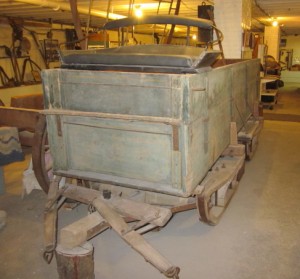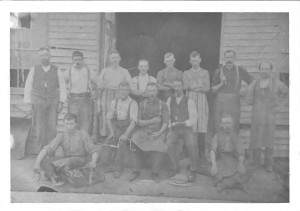Wagons were first developed in Mesopotamia in the middle of the fourth century B.C. and improved upon with the invention of the pivoting front axle during ancient Roman times. The front axle allowed for better steering and turning capabilities. The wagons on display at the Delphos Canal Commission are certainly of a much later date (late 1800’s – to early 1900’s) but none the less of great interest to those of us concerned with the history of Delphos.
Wagons were of great importance to the early settlers for hauling of materials and supplies as well as a means of transportation. Wagons were adapted for use as needed. Curved bottoms kept the load from shifting, lighter weight wagons would use fewer horses, side panels allowed stacking larger loads and canvas covers could be added to protect the cargo. Transporting logs required removing the bed.
Not everyone could afford the expense of feeding a horse to pull the wagon or of actually owning a wagon. Wagons stands, like taxi stands, were conveniently located and you could hire a wagon to transport you and/or your belongings to your destination. Livery stables were found in most populated areas.
The Kollsmith Wagon Works was located at the SE corner of 5th and Main Streets in Delphos, Ohio. (See Photo) They manufactured farm wagons and fancy buggies for their livery trade, and also maintained a complete livery stable on the site. Mr. Kollsmith also had another building on the NW corner of 5th and Main which housed an office, salesroom and a paint shop on the second floor. Approximately 20 men were employed in the Kollsmith Wagon Works. The manufacture of these wagons required wood and iron. Lumber was abundant in this area but the iron would need to be purchased elsewhere. Wood-bending and blacksmithing were needed for the wagon making process. According to a news article found by Bob Holdgreve, dated Feb. 21, 1878, Mr. Kollsmith started his wagon business 24 years earlier in a small shanty with hardly enough windows to light the area.
Our museum has a Kollsmith-made wagon bed sitting on a bobsled-style undercarriage (not originally with the wagon bed) on display at the Delphos Canal Commission. We also have a regular four-wheeled wagon undercarriage from the Wellman Farm and the bed could sit on this as well.
The Delphos Canal Museum has many early Delphos historical manufacturing items on display. Take a new look at some very old and interesting artifacts of early Delphos. The museum is open every Sat. & Sun. from 1-3 pm and every Thurs. from nine to noon. We are located on the west side of Main St. between 2nd and 3rd St. and right along the Miami-Erie Canal. Come visit us soon.
Published in the Delphos Herald on February19, 2011 by the Delphos Canal Commission.















Speak Your Mind